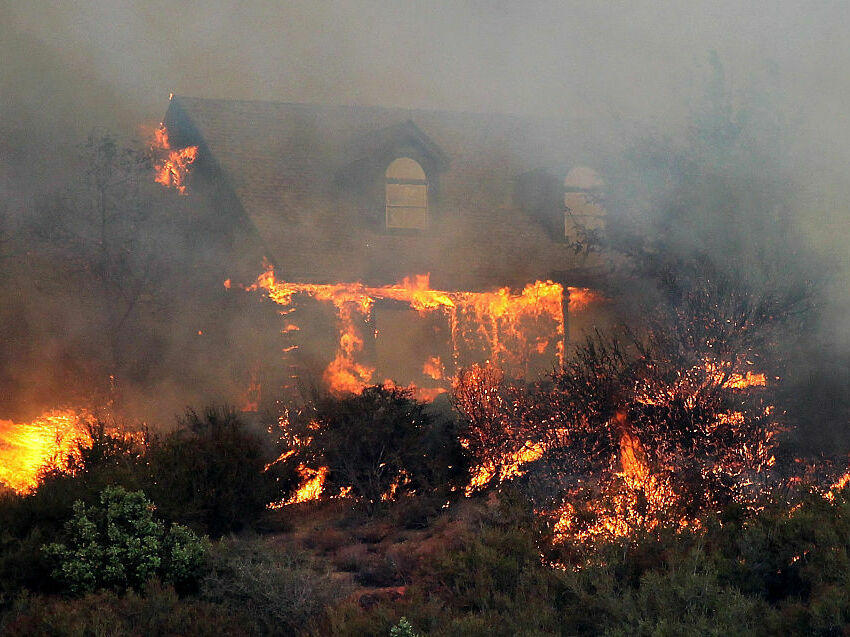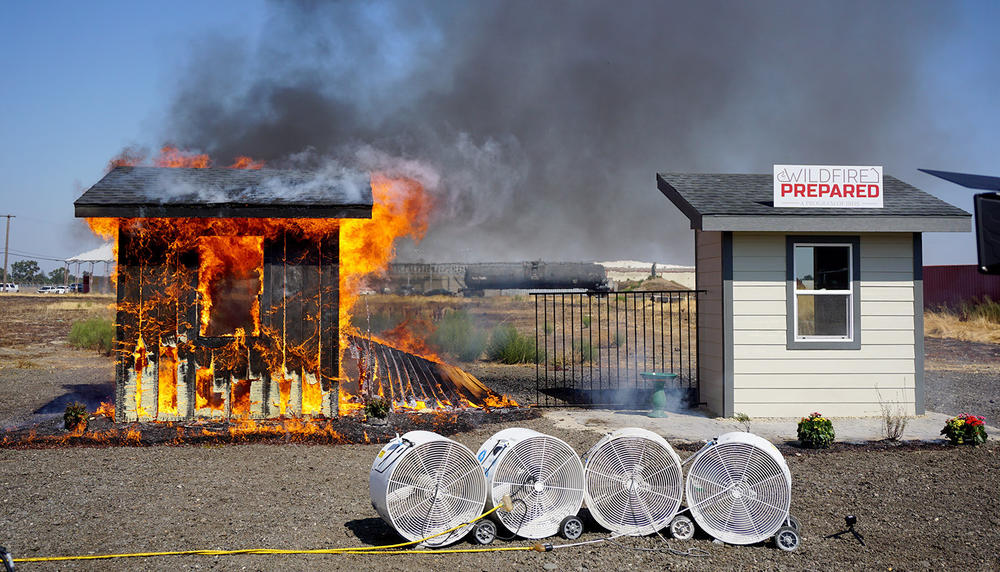Section Branding
Header Content
With wildfires growing, California writes new rules on where to plant shrubs
Primary Content
In most neighborhoods, houses are hugged by greenery – flowers surround the front steps, large shrubs screen the windows. But in wildfire-prone places, such as California, fire experts say this typical suburban template needs to drastically change as human-driven climate change makes intense wildfires more frequent.
California has long had the strongest defensible space rules in the country. Now, it's drafting rules that would make it the first state to limit the vegetation directly next to buildings. In areas at high risk of wildfire, plants within five feet of a house would be strictly limited.
The new rules are not expected to go over well. Many homes have established landscaping along their exterior walls, which homeowners may be reluctant or even refuse to move. State regulators are evaluating whether some plants could safely remain in that zone, like green lawns or mature trees without branches touching the house.
"We understand that it's not going to be a very easy change for some homeowners," says Daniel Berlant, state fire marshal with Cal Fire, the state's firefighting agency. "But the science is very simple: even a green, well-maintained plant will catch on fire and it's going to destroy your home."
Fire experts say it's about flipping the idea of how landscaping is laid out. Walkways and patios should be directly next to a house, instead of plants.
With the costs of wildfires skyrocketing, both in human toll and dollars, California's regulators say communities need to do all they can to reduce the dangers. The upcoming rules could have much broader impacts, since many other Western states have followed California's lead on wildfire policy.
Two buildings, two different outcomes
On a large empty airfield in Sacramento, firefighters light two small buildings on fire.
It's a demonstration, led by the Insurance Institute for Business & Home Safety, a non-profit funded by the insurance industry that studies what makes buildings vulnerable.
Both structures are surrounded by bark mulch, green plants and shrubs. But there's a key difference: around one building, the mulch and shrubs are directly next to the walls. On the other, a stone walkway separates them, acting like a buffer.
Two small spot fires spark in the mulch, simulating a typical ignition in large wildfires where high winds carry embers far ahead of the fire.
"The research shows that the embers are usually the initial point of attack," says Roy Wright, president of the Insurance Institute for Business & Home Safety. "Those embers can be the size of your thumb or even the palm of your hand and can loft up to a half mile."
The fire quickly spreads through the mulch near one building, carrying the flames directly to the walls. The structure eventually burns to the ground. The other building next door survives. The mulch burned until it hit the stone walkway where it stopped.
Defensible space can't guarantee a house will survive a wildfire, but experts say surrounding the outside walls with hardscape, like gravel, walkways or patios, can reduce the risk.
"Wildfire adaptation is going to take a different aesthetic," says Anne Cope, chief engineer at the Insurance Institute for Business & Home Safety. "We need to take our beautiful landscaping and our flowers that we enjoy so much as humans and we need to move that away from the house where we can see it from the window and still enjoy our gardens, just not right up next to the structure."
Moving plants will be a tough sell
With wildfires taking an increasing toll in California, lawmakers passed a bill in 2020 to create an "ember-resistant zone" within five feet of a house. Driven in part by a hotter, drier climate, extreme fires have destroyed almost 40,000 homes and buildings in the last six years statewide, doing billions of dollars in damage.
Now, state authorities are writing the rules for the five-foot zone, also known as "zone 0." The state already has rules for creating defensible space within 100 feet of a structure, which require clearing out dead brush and cutting back tree limbs. The new rules would apply in areas at risk of burning outside city limits, as well as in the zones at highest risk of burning within cities themselves.
The simplest version of the rules could mandate that no vegetation be allowed within five feet of a structure, something that's more easily enforced by fire inspectors. But public acceptance of that would be more than challenging, regulators worry. They're now weighing what kind of vegetation might be allowed, like small plants with space between them, green lawns or groundcover, or mature trees that are cut back sufficiently from a building.
"Emotionally, this is a huge change for people," says Frank Bigelow, assistant deputy director of Cal Fire's Community Wildfire Preparedness & Mitigation. "Most people who are compliant now, won't be compliant."
It's even a tough sell for his own parents, Bigelow says.
"When I told them: out in the front yard, where you have the mulch and you have that little tree in front of the window, all of that is gonna have to come out," he says. "And my dad said 'The heck it is. We paid a lot of money to have that landscaping done. I'm not moving that."
The rules were supposed to be finalized in January, but tensions have led to delays. The regulations will apply to new construction first in 2025, where the changes may be easier to implement as houses are built.
"We've been working with builders and industry to flip-flop the idea: put the walkway right next to the home and put the plants on the other side of the walkway so now you've got that five feet of distance," Berlant says.
For existing homes, the rules would be implemented in 2026. State firefighters say it will take an extensive educational campaign to help homeowners make the transition. One of the biggest motivations could be from insurance companies. As wildfire damage has skyrocketed, Californians are seeing their insurance premiums rise and a few companies have left the state's market completely. A handful are now offering discounts to homeowners who create defensible space around their houses.
"It's the kind of thing that insurers recognize in terms of reducing risk," Wright says. "States across the West are following California's lead."
Copyright 2023 NPR. To see more, visit https://www.npr.org.


